

Getting ready for the classroom of the future. Subscribe to our newsletter and be the first to get the newest updates.
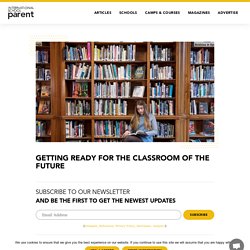
Hybrid teaching: Be Safe, Be Kind, Be Adaptive, Be Imaginative - αℓιѕση уαηg. Reopening school As there has been no local COVID-19 transmission for at least 50 consecutive days in Thailand, we are currently planning on opening the school and welcoming our students physically back to campus in August with precautions.
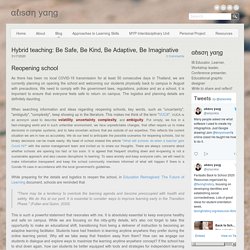
We need to comply with the government laws, regulations, policies and as a school, it is important to ensure that everyone feels safe to return on campus. The logistics and planning details are definitely daunting. When searching information and ideas regarding reopening schools, key words, such as "uncertainty", "ambiguity", "complexity", keep showing up in the literature. This makes me think of the term "VUCA". "There may be a tendency to overlook the learning agenda and become preoccupied with health and safety.
This is such a powerful statement that resonates with me. What Is Distance Learning For? Through the fog of memory, and despite everything that’s happened since, I still vividly remember the last day of school.
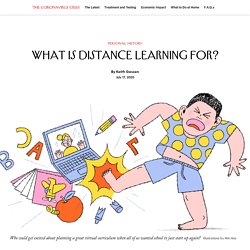
In the morning, I listened to the Mayor on the radio insisting that the schools would not close. Too many vulnerable children got their only meals at school, he said. Too much of the city’s workforce depended on schools for child care. In the afternoon, Emily and I went on our big pandemic shopping run. And then, at 5 p.m. on the dot, I picked up Raffi from his pre-K. “The Mayor doesn’t want to close the schools,” I said. “If he doesn’t close them, we’ll close them,” one of the teachers said. “Attendance is already down,” the other teacher said. That’s when I knew the schools were going to close, and soon. How to Plan and Implement Continuous Improvement In Schools.
Many of the biggest problems of practice have been around a long time and aren’t easy to solve. Too often when trying to improve something leaders jump to solutions before properly examining the problem. Understanding the problem requires valuing many types of knowledge. I love BYU’s plan for holding classes in the fall! □ Outstanding articulation of in-person, online, or somewhere in between. What Does Good Classroom Design Look Like in the Age of Social Distancing? Where we learn matters.
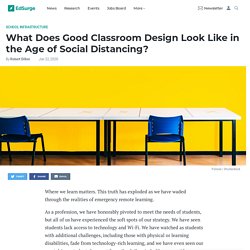
This truth has exploded as we have waded through the realities of emergency remote learning. As a profession, we have honorably pivoted to meet the needs of students, but all of us have experienced the soft spots of our strategy. We have seen students lack access to technology and Wi-Fi. We have watched as students with additional challenges, including those with physical or learning disabilities, fade from technology-rich learning, and we have even seen our most driven students burn out from the daily grind of hours on video conferences and completing assignments online.
NowComment. Keri-Lee Beasley. Podcasts With our students on the move, tapping into the wealth of incredible resources available in the form of podcasts on nearly every topic imaginable makes so much sense.

Assigning a podcast episode or series to listen to, followed by a response (video/post/discussion forum) can be a powerful way to access learning in new ways. By way of example, a combined TOK & English Language & Literature class might explore the Serial Podcast, and investigate some related articles to explore ethics. Resources kindly contributed by Tricia Friedman. Middle Schoolers might listen to episodes from the podcast This I Believe before writing and recording their own episode (as developed by Nathan Lill & Ceci Gomez-Galvez).
Overview of ISS Tools and Guidelines for Use. EP for Classroom - EP for Learning. Online Learning Guidelines. Secondary Virtual School Teacher Prep List. WAB (@WAB_LIVE) / Twitter. Overview - Hong Kong International School. Kathy Schrock's Guide to Everything - Home Page. Online Learning. Inspirational Online Learning Toolbox - For Creators. How to Design for Learning: Four Approaches to Nonlinear Curriculum. Is school designed for the way humans learn?
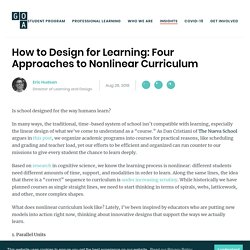
In many ways, the traditional, time-based system of school isn’t compatible with learning, especially the linear design of what we’ve come to understand as a “course.” As Dan Cristiani of The Nueva School argues in this post, we organize academic programs into courses for practical reasons, like scheduling and grading and teacher load, yet our efforts to be efficient and organized can run counter to our missions to give every student the chance to learn deeply. Based on research in cognitive science, we know the learning process is nonlinear: different students need different amounts of time, support, and modalities in order to learn. Along the same lines, the idea that there is a “correct” sequence to curriculum is under increasing scrutiny. While historically we have planned courses as single straight lines, we need to start thinking in terms of spirals, webs, latticework, and other, more complex shapes. 1. 2. 3. 4.
How to Do Online (Distance) Teaching! OREO Online Learning Guidelines - αℓιѕση уαηg. What is in the name of O.R.E.O?

Governments in different countries in Asia Pacific have ordered schools to be closed (or to have extended holidays, depending on how you look at it) due to the coronavirus outbreak. Schools quickly have to put their online learning plans together to support students and families. If teachers have not integrated technology as part of their teaching routine, this can be challenging. Andragogy Archives - Teaching Online Pedagogical Repository.